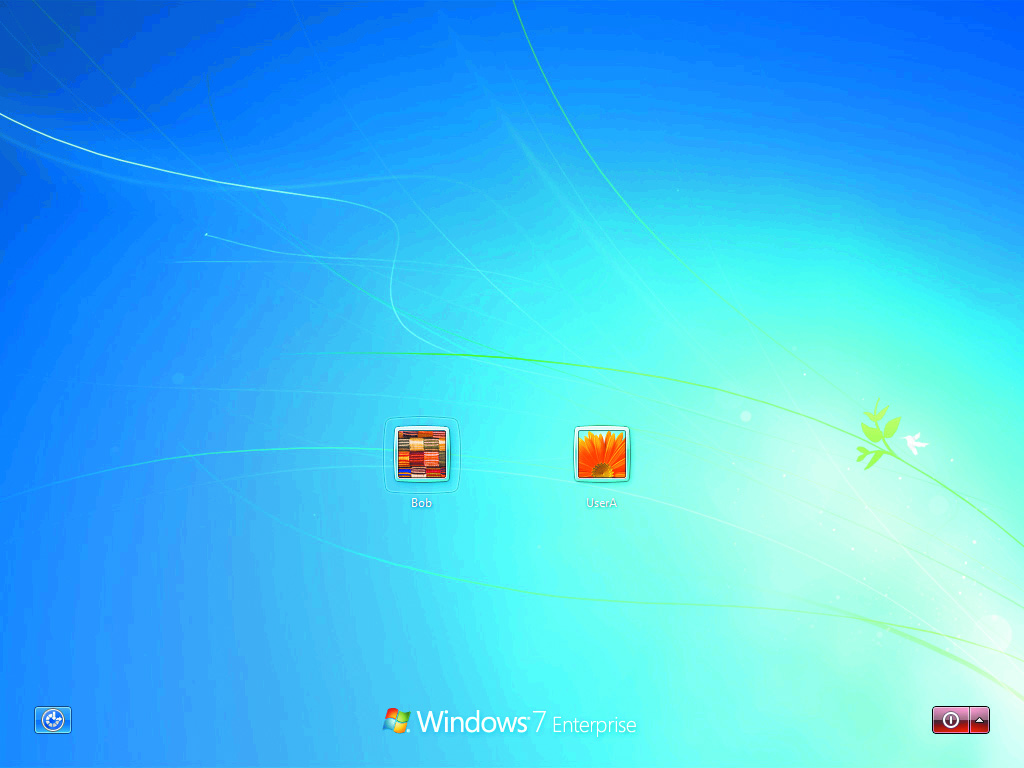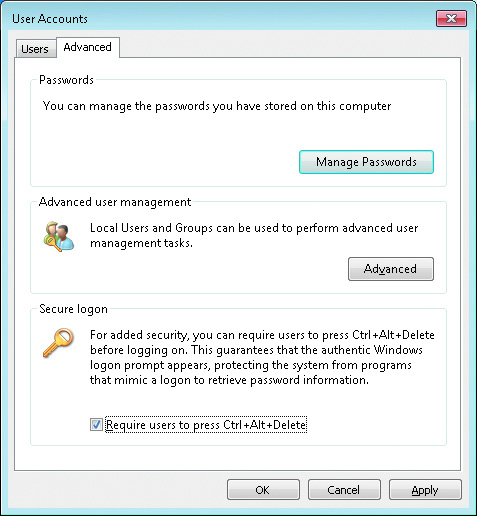User Management
User Accounts
Logon Methods
Users and administrators must log on to a Windows 7 computer before they can use that computer. When you create user accounts, you set up the computer to accept the logon information provided by the Windows 7 user. You can log on locally to a Windows 7 computer using a local computer account, or you can log on to a domain using an Active Directory account.
When you install the computer, you specify that it will be a part of a workgroup, which implies a local logon, or that the computer will be a part of a domain, which implies a domain logon.
Here are the following Windows 7 configurations:
- Standalone: This is Windows 7 computer without network connectivity. All user accounts are local accounts.
- Workgroup member: This is a Windows 7 computer that has network connectivity. Workgroups are logical groupings of Windows computers on the network. All user accounts are local accounts with no synchronization of accounts between computers.
- Domain client: This is a Windows 7 computer that has network connectivity and is a member of a domain. Most of the time a user logs on by using a domain user account, but local user accounts are still supported when required.
Windows 7 support several logon methods:
- Windows Welcome: It is a logon method used by standalone computers and workgroup members. Windows Welcome authenticates users by using the local SAM database.
- Secure Logon: It increases security on your computer by forcing you to press Ctrl+Alt+Delete before logging on. Secure Logon protects your computer from viruses and spyware that may attempt to steal your password. When the computer is a domain client, then secure logon is required. When the computer is a standalone or a workgroup member, secure logon can be selected on the Advanced tab of the advanced User Accounts.
- Fast User Switching: It allows multiple users to have applications running in the background on a Windows 7 computer at the same time. However, only one user can be actively using the computer at a time. For example, User1 logs on to Windows 7 and starts creat- ing a document in Word. User1 then locks the computer before leaving for lunch with the Word document still open. User2 comes to the computer during lunch, logs on to check e-mail, and then logs out. After lunch, User1 returns, logs in, and continues to compose the Word document. Faster user switching allows this to happen. Without fast user switching, User1 would have been logged off automatically when User2 logged on. Any unsaved work in the Word document would have been lost.
- Automatic logon: In some environments it is desirable for the computer to automatically
log on as a specific user each time it is started. This is appropriate for libraries and other public
locations where users are not assigned their own logon credentials. The term kiosk is sometimes
used to refer to an environment where automatic logon is desired.
Automatic logon is configured on the Users tab of the User Accounts.
When you deselect the Users must enter a user name and password to use this computer check box
and click OK, you are prompted for the credentials to be used for the automatic logon. From this
point forward, Windows 7 automatically logs on using the credentials you specified.
If your computer has only one user account (aside from built-in accounts, such as Administrator and Guest), and if that user account doesn't have a password, Windows automatically logs on that user during startup. You won't see the Welcome screen or any other logon screens; Windows launches straight to your desktop.
You might want to set up your computer to log on automatically even if it has more than one user account and even if your preferred user account is password-protected. This kind of logon can be convenient in several situations:
- if you're the primary user of the computer but other people occasionally need to use it;
- if you occasionally need to log on as a different user to install software or perform other tasks; or
- if you have set up a password for your account (so that you can use scheduled tasks or connect remotely, operations that are available only to accounts with passwords), but you still want it to log you on automatically at startup.
When you need to do system maintenance on a computer with automatic logon enabled, you must stop the automatic logon from occurring. Holding down the Shift key during the boot pro- cess stops the automatic logon from occurring. Then you can log on with your own credentials to perform the maintenance tasks.

If you have forgotten your password, click the question mark. (Note: The question mark appears only if you have previously defined a password hint in the Users section of the Control Panel.) If there was a hint defined for your account, Windows will display the hint so that you might remember the password.
If you forget your password, and you previously created a password reset disk, you can use the reset disk to gain access to your account. If you don't have a password reset disk, you'll have to have another user log on using a Computer Administrator account and reset your account's password for you. This process could make you lose access to some information in your account, including website passwords that Windows remembered for you, and if you were using the Encrypted Files feature on Windows 7 Professional, Enterprise, or Ultimate edition, you could lose your encrypted files too.

In environments where multiple users share the same computer, fast user switching is a very important feature. It ensures that a second user can log on to a locked computer without logging off the f rst user and losing their work. This is commonly desired in lab environments and for reception computers.
Windows XP included fast user switching, but only for standalone computers and workgroup members. Windows XP could not perform fast user switching when conf gured as a domain cli- ent. Windows Vista and Windows 7 can perform fast user switching for standalone computers, workgroup members, and domain clients.